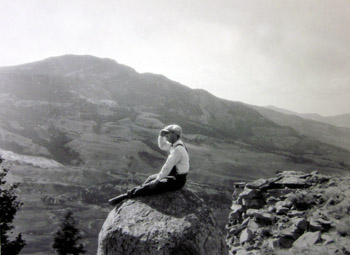Harvey Elmer Stork was born March 28, 1890, in Zoar, Indiana.After service in World War I as an aerial photographer, Stork returned to his studies at Cornell University and received his doctorate in botany about 1920. He joined the faculty of Carleton College as a professor of botany in 1920 and remained there for the course of his career, retiring in 1955.He spent his summers on plant collecting expeditions, primarily to South America, and contributed plant specimens to a number of herbaria, including UC-Berkeley, Harvard University, and the Smithsonian Institution.
In 1927, Stork came to Yellowstone National Park to serve as a seasonal ranger naturalist.His reason for taking a hiatus from international expeditions is unknown, although the recent birth of his first child may be a factor.During the course of his time in Yellowstone, Stork gathered numerous plant specimens for the park's herbarium as well as photographically documenting the plant, animal, and human life.He also contributed chapters to editions of the park's Ranger Naturalist Manual.

Possibly H. E. Stork, sitting on rock outcropping on Mt. Everts, 1929. H. E. Stork Photograph Album, Yellowstone National Park Archives
Stork remained stateside again in 1931 (possibly because a second child was born), as the science coordinator of the Third Scout Naturalist Expedition.A joint program of the National Park Service and the Boy Scouts of America, scouts traveled to several western parks to assist with scientific, interpretive, and maintenance projects.In Yellowstone, the group surveyed the biology of Stevenson Island.By 1932, Stork had resumed his South American research, where he continued to collect specimens at least until 1939. Harvey Elmer Stork died in 1959.
The H. E. Stork collection consists of a photograph album depicting wildflowers, landscapes, and wildlife in Yellowstone National Park, in 1927. The images also depict some of the staff at work and play within the Park.In general, this album is a rare view of the life of a ranger naturalist in the early park service years of Yellowstone.Portions of the album, when matched with the herbarium specimens, may provide additional field data pertaining to the collecting process.
Sources: H. E. Stork Photograph Album, Yellowstone National Park Archives; Stork Photo Collection, Carleton College Archives; U. S. Census Records, U. S. National Archives (via Ancestry.com).
